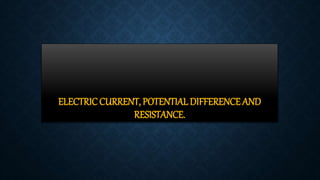
Electric current, potential difference and reietance [Autosaved] [Autosaved].pptx
- 1. ELECTRIC CURRENT, POTENTIAL DIFFERENCE AND RESISTANCE.
- 2. • Name.. M/Atif Stanikzai. • Class.. 11th. • Teacher Name.. ENAMULLAH MEHRABI. • Subject.. Physics. • Year.. 2023. • Source… physics, Cambridge International AS and A level And YouTube, Google.
- 3. CIRCUIT SYMBOLS AND DIAGRAMS. • A circuit diagram is a graphical representation of an electrical circuit. • Circuit diagram are used for the Design, construction and maintenance of electrical and electronic equipment.
- 4. SOME IMPORTANT COMPONENT OF CIRCUIT DIAGRAM. 1. An Electrical Cell: It provides the source of current. In its symbol, the larger terminal is positive, whereas the smaller one is the negative terminal. 2. A Battery: It is a combination of cells, and its utility is the same as the cell. 3. Switch: It is a plug key used to allow or stop the flow if current upon being pressed. It may be an open or closed switch. 4. Wire joint: one device may be connected to the other using wires. This is shown by drawing “blobs” at their point of connectivity. 5. Resistor: It is used to restrict the amount of current flow in the circuit. 6. Ammeter: It is used to measure the current passing at a particular point. 7. Voltmeter: It measures the voltage between two point in a circuit.
- 6. ELECTRIC CURRENT. The net flow of charges through a point in one second is called electric current. • Its measured in amperes (A). • So the formula of current is I=Q/t. • For electric current, the electron should flow in one proper direction.
- 7. CHARGE CARRIERS. • Charge carriers are particles or holes that freely move within a material and carry an electric charge. In most electric circuits and electric devices, the charge carriers are negatively charged electrons that move under the influence of a voltage to create an electric current.
- 8. CURRENT AND CHARGE. • The net flow of charges through a point in one second is called electric current. • In metal conductors the charged particles are free electrons. The electrons are free to move from one ion to another and a net flow of these electrons in one direction is an electric current. • The equation of Current: Current= charge/time. • The equation of Charge: Charge= Current*time.
- 9. EXAMPLE'S • For Current: Calculate the current that gives a charge flow of 180C in time of 38s. • I= Qt… 180C38s= 4.73. I=4.73A. • For Charge: I=0.60A and t=20s. • Q=I*t= 0.60A*20s= 12. Q=12.
- 10. CHARGED PARTICLES. • In physics, a charged particle is a particle with an electric charge. It may be an ion, such as a molecule or atom with a surplus or deficit of electrons relative to protons. It can also be an electron or a proton, or another elementary particle, which are all believed to have the same charge. • Elementary charge e= 1.6*10-19C.
- 11. DERIVING I=NAVE?
- 12. VOLTAGE. • Voltage describes the “pressure” that pushes electricity. The amount of voltage is indicated by a unit known as the volt (V), and higher voltages cause more electricity to flow to an electronic device. • The equation is: V=I*R.
- 13. RESISTANCE • Resistance is the opposition that a substance offers to the flow of electric current. It is represented by the uppercase letter R. The standard unit of resistance is the ohm, sometimes written out as a word, and sometimes symbolized by the uppercase Greek letter omega Ω. • The equation is: Resistance= potential differencecurrent.
- 14. • The potential difference: The energy difference between two points in Electric field is called P.D. • For example: like when we release a ball it accelerates towards the ground. At height its high potential like the energy is 30j, but on the ground its low potential energy is 1j, So the potential difference is 29j. • Electro motive force: is Defined as the total work done per unit charge when charge flows round a complete circuit.
- 15. OHM’S LAW. • Ohm’s law is a relationship between Voltage, current, and resistance. • And Ohm’s law was developed by German physicist name Georg Ohm, • And Ohm’s law has 3 formulas. 1. Voltage= Current*Resistance. 2. Current= VoltageResistance. 3. Resistance= VoltageCurrent.
- 16. ELECTRICAL POWER. • E.P is the rate, per unit time, at which electrical energy is transferred by an electrical circuit. • The SI unit of power is the watt. • General formula of power is P=VI. • And electrical power is: • POWER= energy transferred/time taken
- 17. FUSES.
- 19. POWER AND RESISTANCE. • Power is the rate of doing work and resistance is a particle that helps us to measure opposition to current flow in an electrical circuit. In one of them, power is directly proportional to resistance and in second, power is inversely proportional to resistance. • For resistance R, the power dissipated is given by, • P= I(2)R OR P= V(2)/R.
- 20. CALCULATING ENERGY. • Power= CURRENT*VOLTAGE,. • ENRGAY= Power*time. • Energy transferred= Current*Voltage*time. • OR: W= IVT.
- 21. •THANKS